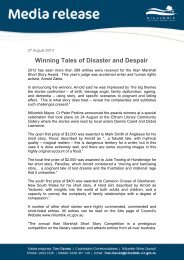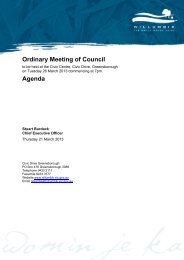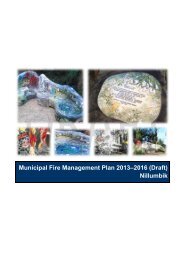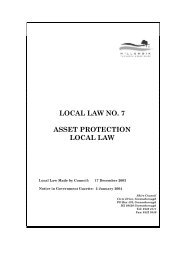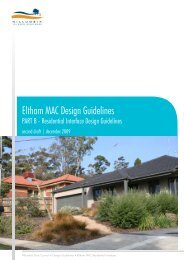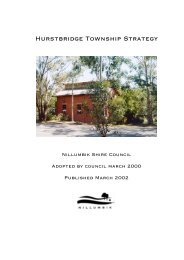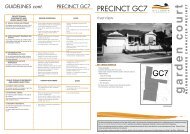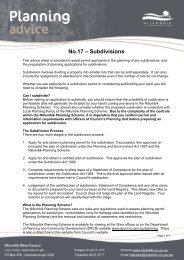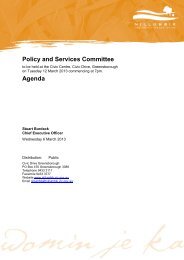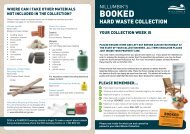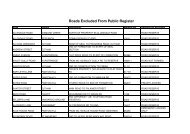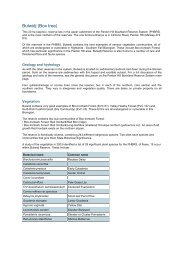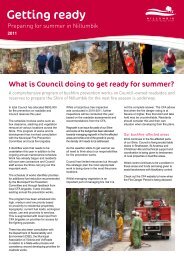Sustainable Water Management Plan - Nillumbik Shire Council
Sustainable Water Management Plan - Nillumbik Shire Council
Sustainable Water Management Plan - Nillumbik Shire Council
You also want an ePaper? Increase the reach of your titles
YUMPU automatically turns print PDFs into web optimized ePapers that Google loves.
The reuse of greywater is becoming a popular<br />
substitute for reticulated water for non-drinking<br />
purposes such as toilet flushing and garden<br />
irrigation. Incorrect use of this source, however, can<br />
cause health and environmental risks as pollutants<br />
and toxins build up in the soil or wash into the<br />
stormwater system.<br />
Domestic wastewater, if permitted to enter<br />
stormwater systems and local waterways, can<br />
threaten water quality due to the particles of dirt,<br />
lint, food and human waste products and chemicals<br />
from cleaning products that it may contain. These<br />
factors can impact on the soil stability of stream<br />
banks and can also promote weed growth. Microbial<br />
contaminants, such as bacteria, viruses and algal<br />
blooms pose significant public health risks while also<br />
impacting on aquatic life.<br />
Swimming pools<br />
There are two public swimming pools in the <strong>Shire</strong><br />
which are under <strong>Council</strong> management (Eltham<br />
Leisure Centre and Diamond Creek Outdoor Pool).<br />
<strong>Water</strong> used in the backwashing processes for the<br />
Diamond Creek Pool facility was previously diverted,<br />
untreated, into the lagoon at the rear of the facility.<br />
Overflow from this lagoon enters the Diamond<br />
Creek. This issue has been rectified with backwash<br />
now connected to the sewer.<br />
In unsewered areas, private swimming pools also<br />
contribute to pollution levels in local waterways.<br />
Unsewered properties cannot discharge wastewater<br />
into their septic systems, as chemicals and the<br />
volume of pool water impact on the effectiveness of<br />
the septic system. Wastewater from backwashing<br />
swimming pools is usually discharged with<br />
stormwater directly into the street.<br />
Nutrient and pollutant levels<br />
As residential development increases and home<br />
gardens are created, nutrients from garden and lawn<br />
clippings, leaf litter and chemicals from fertilisers<br />
can escape with stormwater run-off. Discharge of<br />
toxic pollutants from paints, vehicle use and repairs<br />
and sediment and organic matter generated from<br />
sweeping down paths and driveways into<br />
stormwater drains also impact on water quality.<br />
In rural areas, herbicide, pesticide and fertiliser use<br />
on horticultural crops, such as vineyards, and stock<br />
waste associated with agriculture also contribute to<br />
increased nutrient levels in waterways.<br />
There are three light industrial areas within the<br />
<strong>Shire</strong> located in Research, Eltham and Diamond<br />
Creek. Incorrect work practices from industry can<br />
result in pollution of local waterways from highly<br />
toxic materials. Incorrect disposal of fats and oils,<br />
particularly in the food retail sector, may also have<br />
detrimental effects on water quality.<br />
Gross litter management<br />
As only a small area of the <strong>Shire</strong> is covered by<br />
commercial development, gross litter management<br />
is not a major problem, however it does deserve<br />
consideration in this plan as litter can have a<br />
significant impact on stormwater quality. Of particular<br />
concern are the shopping and industrial areas in<br />
Eltham, Research and Diamond Creek.<br />
Unauthorised dumping of bulk household, garden<br />
and construction waste in the <strong>Shire</strong> can sometimes<br />
occur in and around local waterways as these areas<br />
are often dimly lit and discrete. This can impact<br />
greatly on the surrounding habitat and water quality.<br />
<strong>Water</strong> quality improvement goals<br />
<strong>Water</strong> quality goals are measured by the ICLEI<br />
scorecard which allocates points to different actions<br />
that lead to improvements in water quality (see<br />
Appendix D). Although physical and chemical water<br />
monitoring provide a good indicator of water quality,<br />
improvements cannot be definitively attributed to any<br />
actions undertaken through the program. Therefore<br />
monitoring activities undertaken by <strong>Council</strong> will be<br />
used as an overall indicator of waterway health and<br />
not necessarily of the success of individual projects<br />
undertaken through this program. The actions<br />
listed on the ICLEI scorecard and in the Action <strong>Plan</strong><br />
section of this document are proven to be effective in<br />
improving waterway health.<br />
The ICLEI scorecard allocates either five or 10 points<br />
to a number of water quality improvement actions<br />
which <strong>Council</strong>s can undertake. The minimum goals<br />
required as a part of the ICLEI <strong>Water</strong> CampaignTM<br />
program is 50 points each for corporate and<br />
community sectors. <strong>Council</strong> undertook an evaluation<br />
of the actions listed in this plan in relation to the<br />
ICLEI scorecard to determine achievable goals for<br />
both <strong>Council</strong> and the community.<br />
Strategic Objectives for water quality<br />
improvement in <strong>Nillumbik</strong><br />
1. To ensure best practice in all of <strong>Council</strong>’s<br />
operations to minimise impacts on the<br />
surrounding environment.<br />
2. To provide education, support and incentives<br />
to <strong>Council</strong> staff and the community in<br />
developing practices and modifying behaviour<br />
to reduce impacts on stormwater quality.<br />
3. To incorporate <strong>Water</strong> Sensitive Urban<br />
Design principles in all <strong>Council</strong> upgrades and<br />
developments.<br />
4. Seek funding and identify project opportunities<br />
to implement water quality improvement<br />
throughout the <strong>Shire</strong>.<br />
<strong>Council</strong> will achieve 60 points of the <strong>Water</strong><br />
Quality Action Card by 2010-2011 for <strong>Council</strong><br />
operations and within the community.<br />
32 <strong>Sustainable</strong> <strong>Water</strong> <strong>Management</strong> <strong>Plan</strong> <strong>Sustainable</strong> <strong>Water</strong> <strong>Management</strong> <strong>Plan</strong>



